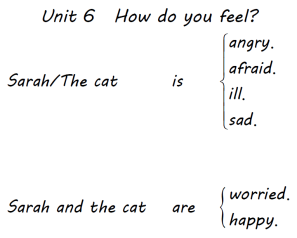人教pep六上英语 Unit 6 The second period第二课时教案
The second period(第二课时)
Part A Let’s learn & Write and say
![]()
▶教学内容与目标
课时教学内容 | 课时教学目标 |
Let’s learn | ·通过图片、课件等,结合教材中Sarah和小猫在不同生活事件中的状态和情绪,学会听、说、读、写下列单词:feel, sad, angry, happy, worried, afraid ·能够结合本部分核心句型表达人物和动物的情绪和心理状态 |
Write and say | ·观察图中人物的动作和表情 ·能够根据自己的生活经验,判断并写出描述人物的情绪和心理状态的形容词 |
▶教学重点
能够听、说、读、写并熟练运用下列单词:feel, sad, angry, happy, worried, afraid。
▶教学难点
能够用所学语言来表达人物和动物的情绪和心理状态。
▶教学准备
PPT课件、课文录音、视频、卡片等。
▶教学过程
1
Step 1: Warm-up & Lead-in
 1. Greetings.
1. Greetings.
2. Sing a song.
Play the song If you’re happy, clap your hands.(出示课件)
Students sing along with the song and do actions after the video.
3. Free talk.
T: What a nice song! How do you feel? Are you happy now?
Ss: …
T: In our life, people have different feelings.
Show some pictures of people on the PPT.(课件出示:人物不同情绪的图片)
Students try to describe the pictures.
Then show some pictures of animals on the PPT.(课件出示:动物不同情绪的图片)
T: Look! Animals also have feelings.
Students try to describe the pictures.
4. Lead-in.
T: Today we’re going to learn how to describe feelings.
Write down the topic “How do you feel?” on the blackboard.
 Step 2: Presentation
Step 2: Presentation
1. Look at Picture 1. Learn the words “angry, afraid”.
T: Sam and Sarah were talking about a cartoon. It’s about a cat. The cat is a police officer. He chases the mice. They’re afraid of him. Why?
Ss: Because the mice are bad. They hurt people. The cat is angry with them.
Show Picture 1 to students.(出示课件)
Students look at the picture carefully.
Talk about the picture with students.
Questions: ①Who is she?/ ②What is it?/ ③What are they doing?/ ④How does she feel?/ ⑤How does the cat feel?/ ⑥Why?
Lead students to answer the questions.
Write down the words “angry, afraid” on the blackboard and teach them.
Help students practice the words in pairs, then in groups like this:
Angry, angry, Sarah is angry. Afraid, afraid, the cat is afraid.
2. Look at Picture 2. Learn the words “ill, sad”.
Show Picture 2 to students.
Students look at the picture carefully.
Talk about the picture with students.
Questions: ①How does the cat feel?/ ②How does Sarah feel?
Lead students to answer the questions.
Write down the words “ill, sad” on the blackboard and teach them.
Help students read the word “ill” through the word “hill”.
Help students read the word “sad” through the word “bad”.
Help students practice the words like this:
Ill, ill, the cat is ill. Sad, sad, Sarah is sad.
3. Look at Picture 3. Learn the word “worried”.
Show Picture 3 to students.
Students look at the picture carefully.
Talk about the picture with students.
Questions: ①Where is the cat?/②How does the cat feel?/③How does Sarah feel?
Lead students to answer the questions.
Write down the word “worried” on the blackboard and teach it.
Use sentences to help students compare the word “worried” with the word “worry”.

Help students practice the word like this:
Worried, worried, Sarah and the cat are worried.
4. Look at Picture 4. Learn the word “happy”.
T: The cat is in the tree. Sarah and the cat are worried. Who can help them? Look at Picture 4.
Show Picture 4 to students.
Students look at Picture 4 carefully.
Talk about the picture with students.
Questions: ①Who’s that man?/②How does the cat feel?/③How does Sarah feel?
Lead students to answer the questions.
Write down the word “happy” on the blackboard and teach it.
Help students practice the word like this:
Happy, happy, Sarah and the cat are happy.
5. Read and practice.
 Play the recording. (课件出示:教材P59 Let’s learn板块的音频)
Play the recording. (课件出示:教材P59 Let’s learn板块的音频)
Students read after it.
Then ask students to read the sentences by themselves and act out.
Step 3: Practice
1. Flashing cards.
Use the word cards to help students practice the words. Students read the words as fast as they can.
 2. Play a game.
2. Play a game.
(游戏说明:教师每次选一名同学到讲台前面,请他/她抽出一张单词卡,并做出相应的表情,其他同学根据他/她的表演使用句型“Are you happy/sad/angry…?”来猜一猜。猜对后让表演的学生试着说:I’m happy/sad/angry…because…)
3. Look and match, then say.
Show some pictures on the PPT.(课件出示:人物不同情绪的图片)
Then show the words one by one. (课件出示:逐个展示情绪类单词)
Students look and try to match the words to the pictures.
Check the answers.(课件出示:答案)
Then talk about the pictures with students.
T: How does he/ she feel?/ How do they feel?
Ss: He/ She is…/ They’re…
Students practice in pairs. Then the teacher asks several students to show to the class, the other students listen and make evaluations.
Step 4: Consolidation & Extension
1. Write and say.
(1)Show the pictures to students. (课件出示:教材P59 Write and say板块的图片) Ask questions and lead students to answer.
Questions: ①What is he/she doing?/②What are they doing?/③How does he/she feel?/④How do they feel?
Students try to answer the questions.
(2)Students write down the words to finish the sentences.
 (3)Check the answers.
(3)Check the answers.
(4)Students point and say.
Students work in pairs.
2. Play the game—“changing the face”.
(1)Ask one student to come to the front of the platform and make a face. The teacher asks “How does he/she feel?” The other students answer. Then the student changes another face. The teacher asks and the other students answer.
(2)Students work in groups to play the game “changing the face”.
1
▶板书设计

▶作业设计
Copy the words three times.
▶教学反思
1.课前利用一首学生耳熟能详的歌曲导入,歌曲明快的节奏调动了学生学习的积极性,舒缓了学生课前紧张的情绪,使他们能较快地投入到英语学习之中。
2.结合图片,利用问题引导学生感知并理解新单词,帮助学生轻松学习新单词,并通过几个活动帮助学生操练新单词。
3.通过“变脸”游戏的创设,将生活植入课堂,以活泼的游戏形式帮助学生进一步巩固所学知识,让学生在玩中学、学中玩。
![]()
▶Teaching Contents & Teaching Aims
Let’s learn
·Be able to listen, speak, read and write the new words “feel, sad, angry, happy, worried, afraid” by observing the pictures and the PPT.
·Be able to express the feelings of people and animals by using the key sentence structures.
Write and say
·Observe the movements and the expressions of the people in the pictures.
· Be able to judge and write down the adjectives to describe the feelings of the characters according to life experience.
▶Teaching Priorities
·Be able to listen, speak, read, write and use the new words “feel, sad, angry, happy, worried, afraid” skillfully.
▶Teaching Difficulties
·Be able to use the target language to express the feelings of people and animals.
▶Teaching Procedures
Teaching Stages | Teacher’ s Activities | Students Activities | Teaching Purposes |
Warm-up & Lead-in | 1. Greetings. 2. Sing a song. Play the song If you’re happy, clap your hands. 3. Free talk. Show some pictures on the PPT. Talk to students. 4. Lead-in. | 1. Greetings. 2. Sing along with the song and do actions. 3. Try to describe the pictures. | Stimulate students’ interest in learning and lead in the topic of feelings. |
Teaching Stages | Teacher’ s Activities | Students’ Activities | Teaching Purposes |
Presentation | 1. Look at Picture 1. Learn the words “angry, afraid”. Show Picture 1 to students. Talk about the picture with students with some questions. Teach the words “angry, afraid”. Help students practice the words in pairs and in groups. | Look at the pictures carefully and talk about them with the teacher. Answer the questions. Learn and practice the words. | Lead in the new words properly. Help students learn the new words through the pictures and the questions. Help students practice the new words in different ways. |
2. Look at Picture 2. Learn the words “ill, sad”. Show Picture 2 to students. Talk about the picture with students with some questions. Teach the words “ill, sad”. Help students read the words “ill, sad” through the words “hill, bad.” Help students practice the words. | |||
3. Look at Picture 3. Learn the word “worried”. Show Picture 3 to students. Talk about the picture to students with some questions. Teach the word “worried”. Use the sentences to help students compare the word “worried” with the word “worry”. Help students practice the word. | |||
4. Look at Picture 4. Learn the word “happy”. Show Picture 4 to students. Talk about the picture with students with some questions. Teach the word “happy”. Help students practice the word. | |||
5. Read and practice. | Read after the recording. Then read and act out. | Make sure students can read the sentences correctly and fluently. | |
Practice | 1. Flashing cards. Use the word cards to help students practice the words. 2. Play a game. Play a guessing game to help students practice the words and the sentence structures. 3. Look and match, then say. Show some pictures and words on the PPT. Let students look and try to match the words to the pictures and then check the answers. Talk about them by using “How does he/she feel?/How do they feel?” “He/She is…/They’re…” with students. Ask students to practice in pairs and show to the class. | 1. Read the words as fast as they can. 2. Play a guessing game to practice the words and the sentence structures. 3. Look and try to match the words to the pictures. Check the answers. Then talk about them and practice in pairs. At last several students show to the class and the other students make evaluations. | Help students practice the new words and use them in sentences. Liven up the class. Cultivate students’ interest in learning. |
Consolidation & Extension | 1. Write and say. (1) Show the pictures to students. Ask questions and lead them to answer. (2) Let students write down the words to finish the sentences. (3) Check the answers. (4) Let students point and say. |
(1)Look at the pictures and talk about them with the teacher. (2)Write down the words to finish the sentences. (3)Check the answers. (4)Point and say. | Help students use the words and the sentence structures properly in situations. Stimulate students’ motivation in English learning. Create a real situation to develop students’ comprehensive language using ability. |
2. Play the game —“changing the face”. (1) Ask one student to come to the front of the platform and make a face. The teacher asks “How does he/she feel?” Ask the other students to answer. Then let the student change another face. The teacher asks and let the other students answer. (2) Let students work in groups to play the game “changing the face”. | (1)One student comes to the front of the platform and makes a face. The other students answer the teacher’s question. Then the student changes another face. The other students answer the teacher’s question. (2)Work in groups to play the game. | ||
Homework | 1. Copy the words three times. 2. Do the exercises. | ||
1
